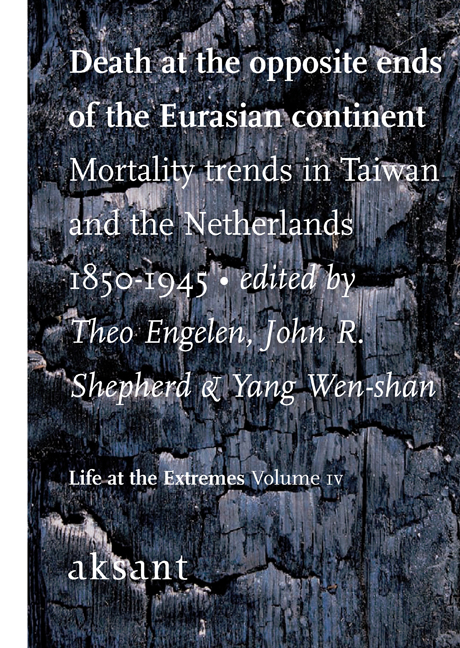 Death at the Opposite Ends of the Eurasian Continent
Death at the Opposite Ends of the Eurasian Continent Book contents
- Frontmatter
- Contents
- Introduction: Death at the Opposite Ends of the Eurasian Continent: Mortality Trends in Taiwan and the Netherlands, 1850-1945
- 1 Trends in Mortality and the Evolution of the Cause-of-death Pattern in the Netherlands: 1850-2000
- 2 Trends in Mortality and Causes of Death in Japanese Colonial Period Taiwan
- 3 Mortality in the Netherlands: General Development and Regional Differences
- 4 Regional and Ethnic Variation in Mortality in Japanese Colonial Period Taiwan
- 5 An Outline of Socio-medical Care in the Netherlands, 19th and Early 20th Centuries
- 6 An Overview of Public Health Development in Japan-ruled Taiwan
- 7 The Demographic History of Smallpox in the Netherlands, 18th-19th Centuries
- 8 Anti-malaria Policy in Colonial Taiwan
- 9 Maternal Mortality in Taiwan and the Netherlands, 1850-1945
- 10 Maternal Depletion and Infant Mortality
- 11 The Massacre of the Innocents: Infant Mortality in Lugang (Taiwan) and Nijmegen (the Netherlands)
- 12 Illegitimacy, Adoption, and Mortality Among Girls in Penghu, 1906-1945
- 13 How Reliable is Taiwan's Colonial Period Demographic Data?: An Empirical Study Using Demographic Indirect Estimation Techniques
- References
13 - How Reliable is Taiwan's Colonial Period Demographic Data?: An Empirical Study Using Demographic Indirect Estimation Techniques
Published online by Cambridge University Press: 22 January 2021
- Frontmatter
- Contents
- Introduction: Death at the Opposite Ends of the Eurasian Continent: Mortality Trends in Taiwan and the Netherlands, 1850-1945
- 1 Trends in Mortality and the Evolution of the Cause-of-death Pattern in the Netherlands: 1850-2000
- 2 Trends in Mortality and Causes of Death in Japanese Colonial Period Taiwan
- 3 Mortality in the Netherlands: General Development and Regional Differences
- 4 Regional and Ethnic Variation in Mortality in Japanese Colonial Period Taiwan
- 5 An Outline of Socio-medical Care in the Netherlands, 19th and Early 20th Centuries
- 6 An Overview of Public Health Development in Japan-ruled Taiwan
- 7 The Demographic History of Smallpox in the Netherlands, 18th-19th Centuries
- 8 Anti-malaria Policy in Colonial Taiwan
- 9 Maternal Mortality in Taiwan and the Netherlands, 1850-1945
- 10 Maternal Depletion and Infant Mortality
- 11 The Massacre of the Innocents: Infant Mortality in Lugang (Taiwan) and Nijmegen (the Netherlands)
- 12 Illegitimacy, Adoption, and Mortality Among Girls in Penghu, 1906-1945
- 13 How Reliable is Taiwan's Colonial Period Demographic Data?: An Empirical Study Using Demographic Indirect Estimation Techniques
- References
Summary
Introduction
When the Japanese first occupied Taiwan in 1895 after the Sino-Japanese war, the aim of the Japanese colonial government was to transform Taiwan into an agricultural base to supply foodstuffs and other raw materials for Japan. To better manage the people and resources of the colony, the Japanese organized investigation and research teams to survey Taiwan's lands and natural resources, register its population, and research its customary law. In 1905, the Japanese government conducted its first modern population census in colonial Taiwan. Later, the colonial government organized six other population censuses in 1915, 1920, 1925, 1930, 1935, and 1940, respectively. Vital statistics reporting based on the household registration system put in place by the Japanese shows that mortality in Taiwan started to drop not long after the Japanese occupation, and declined most significantly after the 1920s. The crude death rate for the Taiwanese population, reported as 34.4 per thousand in 1906, had dropped to 20.4 per thousand in 1937 (Chen 1979: 40-41).
The censuses conducted by the Japanese colonial government have long served as the mainstay of studies of the Taiwanese population in the colonial period. Moreover, Taiwan's colonial period censuses are among the oldest censuses in Asia and have long been highly regarded by professional demographers and social scientists both within and beyond Taiwan (Barclay 1954, Chen 1979). However, many demographers question the accuracy of population censuses and registration records in the developing and/or less developed countries (see Preston et al. 1980; Preston and Hill 1980; United Nations 1983). Taiwan too was an underdeveloped agrarian society during the Japanese occupation. Should we therefore suspect the quality of data generated from Taiwan's population censuses and household registration-based vital statistics?
The quality and completeness of the Japanese census and household registration reporting system in Taiwan very favorably impressed the demographer George Barclay more than five decades ago (Barclay 1954). Yet it is rather hard to believe that all deaths were reported or registered during the colonial period, especially in the early stages of the Japanese occupation and before the household registration system could become fully operational. If deaths were under-reported in any period or for any age group, then we risk underestimating the true death rate.
- Type
- Chapter
- Information
- Death at the Opposite Ends of the Eurasian ContinentMortality Trends in Taiwan and the Netherlands 1850–1945, pp. 349 - 376Publisher: Amsterdam University PressPrint publication year: 2012


